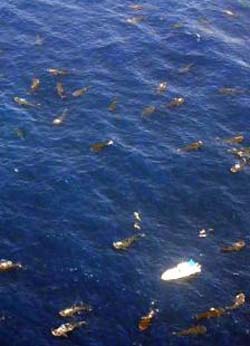Scientists discover the largest assembly of whale sharks ever recorded

This is an aerial photograph of whale sharks feeding at the Afuera aggregation in August 2009. Credit: Oscar Reyes<br>
Aggregations, or schools, of whale sharks have been witnessed in the past, ranging from several individual sharks to a few dozen. However this new research, which involved both surface and aerial surveys, has revealed an enormous aggregation of whale sharks—the largest ever reported—with up to 420 individuals off the coast of the Yucatán Peninsula in Mexico. What brings them together is food.
“Whale sharks are the largest species of fish in the world, yet they mostly feed on the smallest organisms in the ocean, such as zooplankton,” said Mike Maslanka, biologist at the Smithsonian Conservation Biology Institute and head of the Department of Nutrition Sciences. “Our research revealed that in this case, the hundreds of whale sharks had gathered to feed on dense patches of fish eggs.”
While whale sharks may seem conspicuous as the heaviest and longest of all fishes, growing more than 40 feet long, there is still much that is unknown about them. They have a very widespread distribution, occurring in all tropical and sub-tropical regions of the ocean around the world. Understanding this filter-feeder's diet is especially important since food sources determine much of the whale shark's movement and location.
During the dozens of surface trips that team members made to the aggregation, called the “Afuera” aggregation, they used fine nets to collect food samples inside and immediately outside the school of feeding whale sharks. Scientists then used DNA barcoding analysis to examine the collected fish eggs and determine the species. They found that the eggs were from little tunny (Euthynnus alletteratus), a member of the mackerel family.
“Having DNA barcoding is an incredibly valuable resource for this research,” said Lee Weigt, head of the Laboratories of Analytical Biology at the Smithsonian's National Museum of Natural History. “It not only allowed us to know what exactly this huge aggregation of whale sharks were feeding on, not readily done from only physical observations of eggs, but it also revealed a previously unknown spawning ground for little tunny.”
The team of scientists also examined a nearby, less dense aggregation of whale sharks, known as the Cabo Catoche aggregation, off the northern tip of the Yucatán Peninsula. They found that the prey of this group mostly consisted of copepods (small crustaceans) and shrimp. Increased sightings at Afuera coincided with decreased sightings at Cabo Catoche, and both groups had the same sex ratio, implying that the same animals were involved in both aggregations.
“With two significant whale shark aggregation areas and at the very least one active spawning ground for little tunny, the northeastern Yucatán marine region is a critical habitat that deserves more concerted conservation effort,” said Maslanka.
The whale shark is listed as “vulnerable” with the International Union for Conservation of Nature and Natural Resources. Populations appear to have been depleted by harpoon fisheries in Southeast Asia and perhaps incidental capture in other fisheries.
The scientists' findings were published in the scientific journal PLoS ONE, April 2011. In addition to the Smithsonian Institution, team members were from the Comisión Nacional de Áreas Naturales Protegidas in Cancún, Mexico, the Center for Shark Research in Sarasota, Fl., project DOMINO and the Georgia Aquarium, Inc. in Atlanta, Ga.
Media Contact
More Information:
http://www.si.eduAll latest news from the category: Life Sciences and Chemistry
Articles and reports from the Life Sciences and chemistry area deal with applied and basic research into modern biology, chemistry and human medicine.
Valuable information can be found on a range of life sciences fields including bacteriology, biochemistry, bionics, bioinformatics, biophysics, biotechnology, genetics, geobotany, human biology, marine biology, microbiology, molecular biology, cellular biology, zoology, bioinorganic chemistry, microchemistry and environmental chemistry.
Newest articles

High-energy-density aqueous battery based on halogen multi-electron transfer
Traditional non-aqueous lithium-ion batteries have a high energy density, but their safety is compromised due to the flammable organic electrolytes they utilize. Aqueous batteries use water as the solvent for…

First-ever combined heart pump and pig kidney transplant
…gives new hope to patient with terminal illness. Surgeons at NYU Langone Health performed the first-ever combined mechanical heart pump and gene-edited pig kidney transplant surgery in a 54-year-old woman…

Biophysics: Testing how well biomarkers work
LMU researchers have developed a method to determine how reliably target proteins can be labeled using super-resolution fluorescence microscopy. Modern microscopy techniques make it possible to examine the inner workings…





















